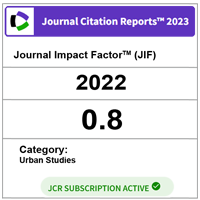Feasibility of Vertical Rainwater Harvesting via In-situ Measurement of Wind-driven Rain Loads on Building Facades in a Tropical Climate
DOI:
https://doi.org/10.11113/ijbes.v8.n3.736Keywords:
Wind-driven rain, Vertical Rainwater harvesting, Building façade, Measurement data, Monsoon windAbstract
Rainwater is an alternative water resource to fulfill sustainable management of freshwater particularly in the regions receive abundant annual amounts of precipitation such as tropical Malaysia. To collect and store rainwater, rainwater harvesting system has been practiced since ancient from horizontal surfaces mostly rooftop of buildings in urban areas. Nowadays, this method in modern urban areas with tall buildings is considered inadequate and uneconomical because the ratio of facade surface areas is much higher than the ratio of roof surface areas. On the other hand, all rain has a horizontal velocity due to wind acting upon rain droplets which is called wind-driven rain (WDR). Growing tall buildings and the presence of WDR phenomenon make building façade surfaces the available promising surfaces to harvest substantial rainwater vertically and more efficiently. This article presents a one-year field measurement results that aims at quantifying the WDR loads impinged on the vertical facade areas of a pilot building located at the main campus of the University Malaya in Kuala Lumpur, Malaysia. Detailed descriptions of the gauge design, building, the measurements of on-site WDR, rainfall duration time, and weather data are presented. Records show that monsoon winds characteristics have significant influence on the WDR loads on the building facades compare to horizontal rainfall intensity. Finally, the collected in-situ data are exploited to validate data and determine WDR coefficient (γ) to estimate the amount of WDR on a building façade via an empirical WDR relationship. Results show the feasibility of each square meter of vertical façade area to supply 12% of non-potable or 4.9% of potable water-usage per capita per day.
References
Adriano, T. E., Antonio, E. M., Rodolfo, G. N., & Mme. (2011). Rainwater Harvesting, Quality Assessment And Utilization In Region I E-International Scientific Research Journal 3(2), 145-155. http://www.eisrjc.com/documents/Rainwater_Harvesting_1325914607.pdf
Back, L. E., & Bretherton, C. S. (2005). The relationship between wind speed and precipitation in the Pacific ITCZ. Journal of climate, 18(20): 4317-4328. doi:https://doi.org/10.1175/JCLI3519.1
Bahari, Y. A. b., Pengarah, K., & Malaysia, J. M. (2017). Jabatan Meteorologi Malaysia, Annual Report 2017. Malaysia: Jabatan Meteorologi Malaysia Retrieved from https://www.met.gov.my/content/pdf/penerbitan/laporantahunan/laporantahunan2017.pdf. Retrieved on 17/02/2020
Bari, M., Begum, R. A., Nesadurai, N., & Pereira, J. J. (2015). Water consumption patterns in greater Kuala Lumpur: potential for reduction. Asian Journal of Water, Environment and Pollution, 12(3): 1-7.
Beorkrem, C., & Damiano, A. (2018). [Kak-Tos]: A Tool for Optimizing Conceptual Mass Design and Orientation for Rainwater Harvesting Facades Humanizing Digital Reality 603-612. Springer.
Blocken, B., & Carmeliet, J. (2004). A review of wind-driven rain research in building science. Journal of Wind Engineering and Industrial Aerodynamics 92: 1079–1130. doi: https://doi.org/10.1016/j.jweia.2004.06.003
Blocken, B., & Carmeliet, J. (2005a). Guidelines for wind, rain and wind-driven rain measurements at test-building sites. Paper presented at the Proceedings of the 7th Symposium on Building Physics in the Nordic Countries:Reykjavik.https://research.tue.nl/en/publications/guidelines-for-wind-rain-and-wind-driven-rain-measurements-at-tes
Blocken, B., & Carmeliet, J. (2005b). High-resolution wind-driven rain measurements on a low-rise building—experimental data for model development and model validation. Journal of Wind Engineering and Industrial Aerodynamics, 93(12): 905-928. doi: https://doi.org/10.1016/j.jweia.2005.09.004
Blocken, B., & Carmeliet, J. (2006a). On the accuracy of wind-driven rain measurements on buildings. Building and Environment, 41(12): 1798-1810. doi:https://doi.org/10.1016/j.buildenv.2005.07.022
Blocken, B., & Carmeliet, J. (2006b). On the validity of the cosine projection in wind-driven rain calculations on buildings. Building and Environment, 41(9): 1182-1189.
Camerlengo, A., & Demmler, M. I. (1997). Wind-driven circulation of peninsular Malaysia's eastern continental shelf. Scientia Marina, 61: 203-211. doi: http://scimar.icm.csic.es/scimar/pdf/61/sm61n2203.pdf
Canavan, D. H. (2008). Facade rainwater harvesting system: Google Patents.
CEN. (2009). Hygrothermal performance of buildings Climatic data Part 3: calculation of a driving rain index for vertical surfaces from hourly wind and rain data. Retrieved from https://www.sis.se/api/document/preview/910850/.Retrieved on 15/01/2020
Cho, E., Yoo, C., Kang, M., Song, S.-u., & Kim, S. (2020). Experiment of wind-driven-rain measurement on building walls and its in-situ validation. Building and Environment, 185: 107269. doi:https://doi.org/10.1016/j.buildenv.2020.107269
Connor, R. (2015). The United Nations world water development report 2015: water for a sustainable world (9231000713). Retrieved from https://sustainabledevelopment.un.org/content/documents/1711Water%20for%20a%20Sustainable%20World.pdf
Dobravalskis, M., Spūdys, P., Vaičiūnas, J., & Fokaides, P. (2018). Potential of harvesting rainwater from vertical surfaces. Journal of Sustainable Architecture and Civil Engineering, 23(2): 49-58. doi:https://doi.org/10.5755/j01.sace.23.2.21606
FJR van Mook. (2002). Driving rain on building envelopes (906814569X). Retrieved from Eindhoven University Press, Eindhoven, The Netherlands: http://fabien.galerio.org/drivingrain/fjrvanmook2002/
Flori, J. (1992). Influence des conditions climatiques sur le mouillage et le sechage d'une facade verticale: CSTB.
Foroushani, S. S. M. (2013). A Numerical Study Of The Effects Of Overhangs On The Wind-Driven Rain Wetting Of Building Facades. (Master), Ryerson University, Toronto, Ontario, Canada. https://doi.org/10.1016/j.jweia.2013.10.007
Hafizi Md Lani, N., Yusop, Z., & Syafiuddin, A. (2018). A review of rainwater harvesting in Malaysia: Prospects and challenges. Water, 10(4): 506. doi:https://doi.org/10.3390/w10040506
Hens, H., & Ali Mohamed, F. (1994). Preliminary results on driving rain estimation, Contribution to the IEA annex 24, Task 2 Environmental conditions T2-B-94/02. Retrieved from https://lib.ugent.be/en/catalog/rug01:000697882. Retrieved on 20/03/2021
Hogberg, A. (1998). Microclimate description: to facilitate estimating durability and service life of building components exposed to natural outdoor climate: Chalmers University of Technology.
Hogberg, A. (1999). Microclimate measurement focused on wind-driven rain striking building surfaces. Paper presented at the Proc. of the 5th Symp. on building physics in the Nordic Countries, Gothenburg.
Hogberg, A. (2002). Microclimate Load: Transformed Weather Observations for Use in Durable Building Design: Department of Building Physics, Chalmers University of Technology.
Hogberg, A., Kragh, M., & van Mook, F. (1999). A comparison of driving rain measurements with different gauges. Paper presented at the Proceedings of the 5th Symposium of building physics in the Nordic Countries, Gothenburg. http://citeseerx.ist.psu.edu/viewdoc/download?doi=10.1.1.606.3604&rep=rep1&type=pdf
Juneng, L., Tangang, F., & Reason, C. (2007). Numerical case study of an extreme rainfall event during 9–11 December 2004 over the east coast of Peninsular Malaysia. Meteorology and Atmospheric Physics, 98(1-2): 81-98. doi:https://doi.org/10.1007/s00703-006-0236-1
Kragh, M. K., & Svendsen, S. (1998). Microclimatic conditions at the external surface of building envelopes. (Ph. D), Technical University of Denmark. Retrieved from https://core.ac.uk/download/pdf/13738237.pdf. Retrieved on 22/02/2017
Kubilay, A., Derome, D., Blocken, B., & Carmeliet, J. (2014). High-resolution field measurements of wind-driven rain on an array of low-rise cubic buildings. Building and Environment, 78: 1-13. doi:https://doi.org/10.1016/j.buildenv.2014.04.004
Lacy, R. (1965). Driving-rain maps and the onslaught of rain on buildings. Paper presented at the 2nd International CIB/RILEM Symposium on moisture problems in Buildings, August 16-19, 1965, Helsinki, Finland.
Lade, O., & Oloke, D. (2015). Modelling Rainwater System Harvesting in Ibadan, Nigeria: Application to a Residential Apartment. American Journal of Civil Engineering and Architecture, 3(3): 86-100. doi:10.12691/ajcea-3-3-5 http://pubs.sciepub.com/ajcea/3/3/5
Lim, E., Das, U., Pan, C., Abdullah, K., & Wong, C. (2013). Investigating variability of outgoing longwave radiation over peninsular Malaysia using wavelet transform. Journal of Climate, 26(10): 3415-3428. doi:https://doi.org/10.1175/JCLI-D-12-00345.1
Masters, F. J., Gurley, K. R., Prevatt, D. O., Rivers, B., & Kiesling, A. (2013). Wind-Driven Rain Effects on Buildings, Task Committee on Wind-Driven Rain Effects, Environmental Wind Engineering Committee, Technical Council on Wind Engineering, ASCE (12-00005-00). Retrieved from http://www.floridabuilding.org/fbc/commission/FBC_0613/HRAC/2012_2013_Task_3_Final_Report.pdf. Retrieved on 15/01/2017
MESTECC. (2018). Malaysia’s Third National Communication and Second Biennial Update Report submitted to the United Nations Framework Convention on Climate Change in September 2018. Putrajaya, Malaysia: Ministry of Energy, Science, Technology, Environment and Climate Change Retrieved from https://unfccc.int/sites/default/files/resource/Malaysia%20NC3%20BUR2_final%20high%20res.pdf. Retrieved on 16/03/2020
MWA. (2018). Malaysia Water Industry Guide. Retrieved from The Malaysian Water Association, Kuala Lumpur, Malaysia: Retrieved on 22/03/2021
SDI. (2003). A Study on Preventing Flood Damage and Water Saving through Rainwater Utilization. Seoul Development Institute, Seoul, Korea.
Silva, C. M., Sousa, V., & Carvalho, N. V. (2015). Evaluation of rainwater harvesting in Portugal: Application to single-family residences. Resources, Conservation and Recycling, 94: 21-34. doi:https://doi.org/10.1016/j.resconrec.2014.11.004
Suhaila, J., & Jemain, A. A. (2009). Investigating the impacts of adjoining wet days on the distribution of daily rainfall amounts in Peninsular Malaysia. Journal of Hydrology, 368(1-4): 17-25. doi:https://doi.org/10.1016/j.jhydrol.2009.01.022
Tan, K. C. (2018). Trends of rainfall regime in Peninsular Malaysia during northeast and southwest monsoons. Journal of Physics: Conference Series, 995(1): 012122. doi:https://doi.org/10.1088/1742-6596/995/1/012122
Tangang, F. T. (2001). Low frequency and quasi‐biennial oscillations in the Malaysian precipitation anomaly. International Journal of Climatology: A Journal of the Royal Meteorological Society, 21(10): 1199-1210. doi:https://doi.org/10.1002/joc.676
UNFCCC. (2015). Malaysia National Communication to The UNFCCC. Putrajaya, Malaysia: Ministry Of Natural Resources And Environment Malaysia Retrieved from https://unfccc.int/resource/docs/natc/malnc2.pdf.Retrieved on 22/03/2021
Van Mook, F. (1998). Description of the measurement set-up for wind and driving rain at the TUE. Report FAGO, 98, 44. https://www.persistent-identifier.nl/urn:nbn:nl:ui:25-f00fc883-07f8-4d9d-873e-e898d80750f1
Wong, C., Liew, J., Yusop, Z., Ismail, T., Venneker, R., & Uhlenbrook, S. (2016). Rainfall characteristics and regionalization in Peninsular Malaysia based on a high resolution gridded data set. Water, 8(11): 500. doi:https://doi.org/10.3390/w8110500
Wu, W., Dandy, G. C., Maier, H. R., Maheepala, S., Marchi, A., & Mirza, F. (2017). Identification of optimal water supply portfolios for a major city. Journal of water resources planning and management, 143(9): 05017007.
WWAP. (2019). The United Nations World Water Development Report 2019: Leaving No One Behind. Retrieved from https://reliefweb.int/sites/reliefweb.int/files/resources/367306eng.pdf12/04/2020
Downloads
Published
How to Cite
Issue
Section
License
Copyright (c) 2021 International Journal of Built Environment and Sustainability

This work is licensed under a Creative Commons Attribution-NonCommercial-ShareAlike 4.0 International License.
Copyright of articles that appear in International Journal of Built Environment and Sustainability belongs exclusively to Penerbit Universiti Teknologi Malaysia (Penerbit UTM Press). This copyright covers the rights to reproduce the article, including reprints, electronic reproductions or any other reproductions of similar nature.
Authors who publish with this journal agree to the following terms:
- This Journal applies Creative Commons Licenses of CC-BY-NC-SA
- Authors retain copyright and grant the journal right of publication with the work simultaneously licensed under a Creative Commons Attribution License that allows others to share the work with an acknowledgement of the work's authorship and publication in this journal.
- Authors are able to enter into separate, additional contractual arrangements for the non-exclusive distribution of the journal's published version of the work (e.g., post it to an institutional repository or publish it in a book), with an acknowledgement of its publication in this journal.
- Authors are permitted and encouraged to post their work online (e.g., in institutional repositories or on their website) prior to and during the submission process, as it can lead to productive exchanges, as well as earlier and greater citation of published work (See The Effect of Open Access).








